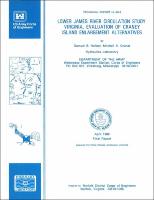Please use this identifier to cite or link to this item:
https://hdl.handle.net/11681/13528| Title: | Lower James River Circulation Study, Virginia : evaluation of Craney Island enlargement alternatives |
| Authors: | United States. Army. Corps of Engineers. Norfolk District Heltzel, Samuel B. Granat, Mitchell A. |
| Keywords: | Craney Island Hydrodynamics Sedimentation Sediment transport Deposition Estuarine circulation Estuary Estuaries James River (Va.) Flow convergence Numerical modeling Numerical model Mathematical modeling Mathematical model Finite element method |
| Publisher: | Hydraulics Laboratory (U.S.) Engineer Research and Development Center (U.S.) |
| Series/Report no.: | Technical report (U.S. Army Engineer Waterways Experiment Station) ; HL-88-8. |
| Description: | Technical Report Abstract: This report presents results from the numerical model investigation whose primary objective was to assess general changes in circulation, currents, and sedimentation associated with six proposed alternative expansion geometries of the Craney Island confined disposal facility. An additional objective of the study was to assess the effects of each of the six alternative geometries on the reported estuarine circulation cell (flow convergence) off Hampton Flats and Newport News Point. This numerical model investigation used the TABS-2 finite element numerical models RMA-2V for hydrodynamics and STUDH for sedimentation with a modified version of an existing numerical mesh of the Lower James River. Other information presently available regarding the estuarine circulation and flow convergence observed off Newport News Point and Hampton Flats was reviewed. With the exception of the Newport News Channel, results from the numerical hydrodynamic modeling indicated no plan to base velocity differences greater than ±0.06 fps at any of the critical areas of interest. Velocity differences greater than 0.10 fps were indicated for the Newport News Channel; channel plan velocities always exceeded base velocities with maximum ebb velocity differences greater than maximum flood velocity differences. Plans with northward extensions resulted in the largest increases. The greatest changes, less than 0.35 fps on ebb and 0.25 fps on flood, were indicated for plans A and B, the largest expansion alternatives also involving westward expansions. Subtle localized circulation variations, generally within 16,000 ft adjacent to and north and northwest of Craney Island, were identified in base to plan comparison vector plots. Results from the numerical sedimentation modeling showed that plan to base shoaling index values (plan-predicted sedimentation divided by base-predicted sedimentation) were all within 90 to 110 percent at the critical areas of interest. The Nansemond River entrance was the only area considered to demonstrate any distinct changes in base and plan sedimentation. Considering the existing low sedimentation in the critical areas examined, the indicated differences are well within ordinary field survey detection limits. Alternatives A, D, and F may impact water quality characteristics as a result of a reduced circulation zone between the Craney Island extension and the mainland. Appendix A contains general information on the finite element method. A brief description of RMA-2V and STUDH appears in Appendices B and C, respectively. |
| Rights: | Approved for public release; distribution is unlimited. |
| URI: | http://hdl.handle.net/11681/13528 |
| Appears in Collections: | Technical Report |
